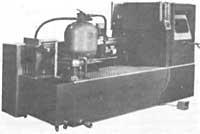Waterjet on motorways
Water jets are being used on highways faster than sound and sand as abrasives to lift concrete fragments. At the junction of Midlands and Vfawr (Wales) for example, traffic is being done nonstop on bridges. This technology can remove the foundation of reinforced concrete beams without damaging steel bars.
The transportation department has demonstrated this system at the crossroads of the Midlands highways to form some weakened beams and the noise and vibration produced by these intense jets of water are acceptable.
The engineer Gifford and Partners of Wales has prepared this technique to solve the two sides of the Vfawr bridge, which holds the three-way highway from the four beams. This bridge belongs to the A465 motorway and has a height of 35 meters.

The final design of the British water engines is tungsten carbide with circular access to water. The solution is angular. If the length of the thrower tube is 5 times its diameter, the propeller performance is 0'95. The softness of the inner tube surface is also important for good performance. If the polishing of the inner surface is done with three microns diamonds (instead of five), the loss of power in the projector is 2 or 3 percent.
The use of this type of sandless launchers at a pressure of 550 bar allows to easily eliminate the additions of the foundation and the internal males of the molded parts.
Sheldon Industrial's technical director, John Griffiths, has just confessed in meetings with water propellants that if the launcher has abrasive and pressure of 1000 bars, in a few seconds can harden the 9 mm thick steel plate.
According to Reliance Hydriotech, the cutting weapon is being prepared. Abrasive bushings will cut the metals as fast as the flame of fire. According to the head of the designer, they have not yet found anything that cannot be cut.
Moreover, the use of cutting water has its advantages in hazardous environments. This water system is very appropriate in areas where there is explosion and fire risk (coal mines, chemical factories, oil platforms, refineries, etc. ). Even though abrasive grains occasionally hit a spark on the ground, the water immediately goes out. More than 100 water, methane, and ethane jet tests have been conducted in the hydrogen atmosphere (in the laboratories of the Boston Department of Health and Safety) and in no case could they cause explosions.
High pressure and abrasive jet generate an atmosphere harmful to breathing. That's why the Reliance Hydrotech have invented a closed room to clean parts, such as molded parts. The operator handles the projector from outside the room, looking through a window.
Desmond Knight, director of the company, says that in this work there does not seem to be many possibilities to use the robot, since for any visual system the Working Conditions around the jet would be too hard.
Abrasive sand, which is absorbed in moderation by the trigger itself attracted by the vacuum produced by the water jet. The abrasive grain spirals and accelerates water currents quickly.
On some highway bridges, water has retained salts to steel bars inside the beams. The bars have been oxidized and the cracked concrete has been stretched. Mr. Griffiths wants to install an installation to each damaged beam. This installation would consist of two launchers that, automatically controlled, would circulate through the beam. In each leg it would generate a layer between 2 and 5 cm. Steel bars at 10 cm would be exposed and without any damage. These bars would be cleaned and repaired.
According to Griffiths, this repair can be done under the bridge. Therefore, the repair would be done without stopping traffic. But they seem to have enough work to keep the facility running for 4 or 5 years.
Water launchers can have different uses. They can be used in coal mines (in surface level and not in subsoil), for example. Also for cutting materials with great precision.





